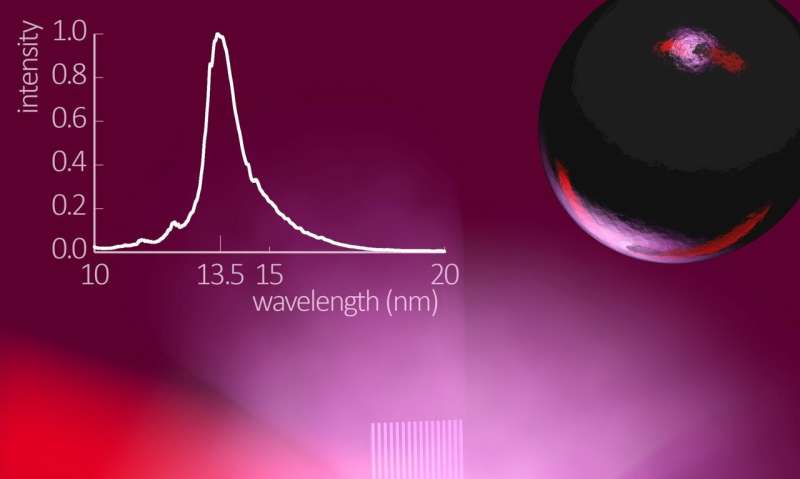The exceptional origin of EUV light in hot tin plasma

Extreme ultraviolet light (EUV light) does not naturally occur on Earth, but it can be produced. In nanolithography machines, EUV light is generated using an immensely hot tin plasma. Researchers at ARCNL, in close collaboration with the American Los Alamos National Laboratory, have unraveled how such a plasma emits EUV light at the atomic level, and have made unexpected discoveries, reporting that all excited energy states of tin were found to have the right energy to emit EUV light. The researchers published their findings in Nature Communications on May 11.
State-of-the-art lithography machines use EUV light to print extremely small structures on chips. EUV light with a wavelength of around 13.5 nanometers can be efficiently reflected using advanced multilayer mirrors. The light source in such machines is a tin plasma. To produce it, a drop of tin is heated by a laser to a point where it becomes plasma that emits EUV radiation. Exactly how this process takes place is one of the questions that ARCNL researcher Oscar Versolato hoped to answer with the ERC grant he received in 2018. Together with the American researcher James Colgan, his team succeeded in obtaining a far more complete and accurate answer to that question than previously possible.
Energy packets
"If we heat tin to an extremely high temperature, up to 400,000 degrees Celsius, then the atoms fall apart into free electrons and positively charged ions of differing charges. Furthermore, many of these ions are in an excited state: One or more of the orbiting electrons has an extra portion of energy. These electrons circle in an orbit that is further from the atomic nucleus than the closest orbit. When they return to an orbit closer to the nucleus, that additional energy is released in the form of EUV radiation," Versolato explains. "In a tin ion, a single electron can have such an extra energy packet, but it is also possible that several electrons simultaneously have one. They orbit in the first, second third or even the fourth shell around the atomic nucleus. However, the probability of an electron reaching a higher excited state becomes increasingly smaller with each step upward. It was therefore generally assumed that electrons in the first excited state mainly emitted the EUV light in tin plasma."
Experiment versus supercomputer
As experimental measurements of the EUV spectrum did not entirely agree with that assumption, the researchers suspected that higher energy states also made a contribution to the EUV light emitted by the tin plasma, but the exact process was unclear. Versolato says, "The only way to obtain certainty about that was to calculate all possible energy transitions in the tin plasma, an almost impossible task. There are more than 10 billion possible transitions between energy levels for electrons in tin plasma."
Only a supercomputer is powerful enough to perform such calculations. The physicists from ARCNL therefore sought collaboration with the Los Alamos National Laboratory, which has both supercomputers and experts in the area of atomic physics. "As a result of this collaboration, we were, for the first time, able to describe how tin plasma emits EUV light with incredible precision and completeness. And that yielded surprising insights."
Unique EUV source
By comparing their lab experiments with the calculations from Los Alamos, the researchers discovered that it is not just electrons that return from the first excited energy state which emit light at 13.5 nanometers. Electrons in higher shells also contributed to this, because the energy difference between successive excited states is the same. "This means that each electron that returns to a lower energy state contributes to the emission of 13.5 nanometer light. That property makes tin plasma unique and exceptionally suitable as an EUV source," says Versolato.
The fundamental research with the tin droplet source and laser setup has brought the unusual properties of tin plasma to light. Versolato: "We have acquired surprising new knowledge about the creation of EUV light. Due to our better understanding of how the process works, we might be able to contribute to the further optimization of the EUV sources in the future."
More information: F. Torretti, J. Sheil, R. Schupp, M.M. Basko, M. Bayraktar, R.A. Meijer, S. Witte, W. Ubachs, R. Hoekstra, A.J. Neukirch, J. Colgan, O.O. Versolato, Prominent radiative contributions from multiply-excited states in laser-produced tin plasma for nanolithograph, Nature Communications, 11 May (2020), DOI: 10.1038/s41467-020-15678-y
Journal information: Nature Communications
Provided by Advanced Research Center for Nanolithography





















